Frank Matcham
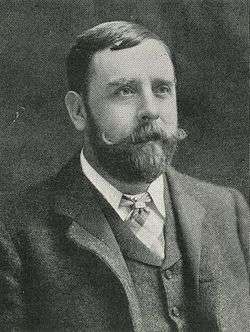
Frank Matcham (22 November 1854 – 18 May 1920) was an English theatrical architect and designer. During his 40 year career, he was responsible for the design and construction of over 90 theatres and the redesigns and refurbishments of a further 80 throughout the United Kingdom. According to the dramatist, Alan Bennett, there was a Matcham theatre in every corner of the UK. Matcham was perhaps best known for his work in London, under Moss Empires, which included the designs of the Hippodrome (1900), Hackney Empire (1901), London Coliseum (1903), London Palladium (1910), and the Victoria Palace in 1911.
Matcham was born in Newton Abbot, Devon, where he became apprenticed at the age of 14 to the architect, George Sondon Bridgeman. He moved to London, aged 21, where he joined the architectural practice of J. T. Robinson, who was later to become his father–in–law. Under Robinson, Matcham completed his first solo design, the Elephant and Castle theatre, which opened in June 1879. He took over Robinson's business upon his death and continued the designs of various provincial theatres. Matcham formed his own practice, Matcham & Co. in the 1880s and enlisted skilled craftsman who he used on all of his projects. His first major association came in the 1880s when he was employed to design and refurbish theatres belonging to the Revill family who owned many of the Victorian theatres throughout the United Kingdom.
Matcham's most successful period was between 1892 and 1912 when he worked extensively for Moss Empires, a theatrical company headed by Edward Moss and run by Oswald Stoll. Under Moss and Stoll, he completed 21 theatres, most of which were in the provinces. During this period, although not with Moss Empires, he completed the designs for the Tower Ballroom at Blackpool Tower, the Grand Theatre, Blackpool, both in 1894, and the County Arcade in Leeds in 1900. Matcham retired to Southend-on-Sea, Essex, shortly before the First World War, where he died of a heart attack, brought about by a blood infection, in 1920. Brian Mercer Walker notes from Matcham's personal archives that the architect was "a man of remarkable vigour and enthusiasm for life ... he possessed a tranquility of mind and [had] a great sense of humour and fun."[1]
Biography
Early life
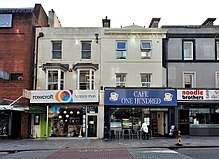
Matcham was born in Newton Abbot, Devon.[2] He was the second of nine children and the eldest son to Charles Matcham (1826–1888), a brewer, and his wife, Elizabeth née Lancaster (1830–1905).[3][n 1] Charles Matcham moved his family from Newton Abbot to Union Street, Torquay, in 1857. He secured a job as a manager of a Brewery and a Malthouse.[2] Frank was educated in Babbacombe, although it is not known at which school.[6] He showed an early interest in architecture and became apprenticed at the age of 14 to a local architect called George Soudon Bridgeman.[7][n 2] The apprenticeship lasted 18 months until Matcham was offered a job at a quantity surveyor's office in London in around 1868.[12]
Working in the capital afforded Matcham the benefit of being able to study architecture under a number of different professionals. His training under a quantity surveyor taught him how to draw up estimations, interact with building contractors, and introduced him to calculations, something which he was unlikely to have been taught at school.[13] It also taught him the importance of working on tight schedules and for strict customers.[14]
In his spare time he visited many of London's buildings, of varying ages, but took a particular liking to theatres and music halls. A building of special interest to Matcham was the newly completed Gaiety Theatre in the Strand, designed by Charles J. Phipps. Matcham was impressed at how Phipps utilised a small, awkward plot but still managed to build a theatre of normal size. It is probable that Matcham drew some inspiration from the Gaiety in some of his later buildings as most of his designs were built on restricted plots of land.[13]
It is not known for how long Matcham spent in London, although it was not uncommon for an amateur architect to take up to six years to learn their trade. The theatrical author Görel Garlick gives a period of around three years as being a likely time, which would seem probable as by 1871 Matcham was back in Torquay and under the guidance of Bridgeman, this time as his chief assistant. Bridgeman was eager to take advantage of Matcham's experience in London and asked him to help on the former's re-design of the Lyceum Theatre in Torquay.[13] It is not known in what capacity Matcham helped Bridgeman as records no longer exist, or to what extent the Lyceum was changed from the original design.[15]
Isaac Singer, the American businessman, moved from France to Devon in late 1871. His intention was to buy a large property in the English countryside for his family. His attempt at buying Isambard Kingdom Brunel's estate was unsuccessful so he purchased the Fernham Estate, in Torbay, on which Oldway Mansion was eventually built. Singer commissioned Bridgeman's office to undertake the design and instructed that a theatre be built within the house. In an edition of The Builder, dated 1873, Matcham was named in the request for tender section as being the accepted party to work alongside Bridgeman on the Oldway Mansion project.[16] Garlick considers it entirely possible that Matcham was given sole responsibility for the design of the theatre because of his educational experiences in London. Singer spared no cost in terms of Oldway Mansion's construction; he sourced the finest materials from around the world and instructed Bridgeman to design the interior in exuberant French style. Garlick notes that it was highly likely that Singer's exuberance would have influenced someone as architecturally impressionable as Matcham whose later theatres used such extravagant decoration.[17]
Entry into the family business
In around 1875, soon after the completion of Singer's house, Matcham secured a job with J. T. Robinson's office in London.[18][n 3] The employment allowed Matcham to become more familiar with, what the biographer Brian Mercer Walker calls, "theatre design of a high order".[11] Matcham's time under Robinson was brief when the latter died unexpectedly at the family home in Bloomsbury Square, London, in 1877. Matcham, who, that year, had married Robinson's daughter, Maria, was entrusted by the family to continue with Robinson's designs which included the refurbishment of the Elephant and Castle Theatre, as well as the modifications to the Cambridge Music Hall in Shoreditch.[20]
By the mid-1870s around 137 theatre fires had been reported in the United Kingdom which prompted parliament to create the Metropolis Management and Building Act in 1878 which created safety rules for developers to abide by. The rules were problematic for Matcham whose schedule for the Elephant and Castle Theatre had to be increased by six months.[21]
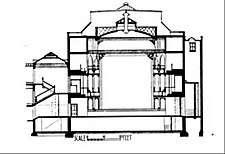


In 1882 Matcham took on the redesign of the Grand Theatre in Islington. The Grand was an important project for Matcham owing to the building's unobstructed sight lines to the stage; its holding capacity; and the prompt construction, something which he latterly became known for. The Grand was used as an educational showpiece to amateur architects and it was often visited and commented on by architectural critics and journalists.[22] In one of the three volumes, entitled Modern Opera Houses and Theatres, which were published between 1896 and 1898, the author Edwin Sachs, made reference to the Grand's "good sighting and acoustics of the auditorium, economy of space and cost, and rapidity of execution".[23] Matcham's improvement on sight lines were a result of his use of cantilevered steel. This new design allowed for the balconies to protrude into the auditorium without the use of the supporting pillars. The new design allowed for seating capacities to be increased and for the audience to view the entertainment more freely. It was a design that Matcham patented and incorporated into all his future designs.[24]
The Paragon in Mile End, London, in 1882 was to be Matcham's next major project. The design was one of importance, according to Walker, as it showed a great emphasis towards the ventilation system which used a sun burner in the roof and warm air ducts, six feet above ground level, which omitted draughts.[25] The builders of the theatre, Crowder and Payne, advertised the venue as being "the best ventilated theatre in London".[26] It opened in May the following year to much praise for its achievements in audience comfort.[27] The success of the Paragon allowed Matcham to open up his own office in Belfast in 1884.[25]
Work under the Revills
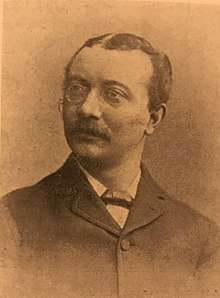
Outside of London, and prior to 1886, Matcham had had only two designs commissioned: Hengler's Grand Cirque and the Royalty Theatre, both in Glasgow.[28] In 1879 he started work on the redesign of the Royalty,[29] a playhouse originally designed by James Thomson and one that had been built on the first floor of a four-storey building. The layout was problematic for Matcham as it had no ground floor and he had to make a series of adjustments. To compensate for this, he concentrated more on the theatre's ventilation system and came up with a new design which involved the installation of an exhaust duct over the auditorium gas light which caused the heat from the burners to rise up and create a movement of air through the theatre. It was a design that he also used on the Gaiety, Matcham's second Glaswegian theatre. The Royalty took four weeks to complete and was largely inexpensive, two things that helped excel his reputation.[22]
Matcham met the actor and theatrical manager James Elliston in 1886.[n 4] Elliston, a native of Edinburgh, had come to hear of the architect through his work in Glasgow and commissioned him to reconstruct the side boxes and gallery and to improve the acoustics and ventilation system at his theatre, the Theatre Royal, Blackburn. Through Elliston, Matcham was introduced to William J. Revill, the proprietor of the People's Temperance Hall in Stockport.[30] The Revill family were influential in theatrical circles with their connection to the stage going back to the 18th century.[31]
Revill contracted Matcham to draw up designs for a new building after the hall was destroyed by a fire in 1887. The new building, as with most of the Revill family's theatres, was to be named the Theatre Royal and Opera House; it was completed to schedule the following year. The finished structure was considered to be "state of the art" by the town's magistrates who granted an entertainments licence that June.[n 5] The Era considered the new building to be "undoubtedly one of the finest theatres in the country".[33] According to the biographer Michael Sell, Matcham's relationship with Elliston helped the young architect to become a nationally recognisable name in theatrical architecture and brought him to the forefront of his profession.[30]
Matcham received instruction in 1888 from the William Revill's son, the theatre manager Wallace Revill, to design a new theatre on some land that he had purchased in St Helens, Merseyside in 1884. The new theatre was named the Theatre Royal and Opera House. It was constructed of brick with stone dressings and comprised an orchestra pit, stalls, a dress circle of three rows, an upper circle, which had the unusual feature of its own retiring rooms, and a very large gallery which allowed for unobstructed views. The entrance façade was built in the classical style with three wide bays of giant pilasters.[34] On the theatre's opening night the following year, Elliston called the building "one of the most beautiful theatres [he] had ever seen".[35]
In addition to the Stockport theatre under Revill, Matcham received another instruction from Elliston, this time to rebuild the Theatre Royal and Opera House, in Bolton, which had caught fire on 4 January 1888. Elliston's only requirement was for the building to be completed within a 20-week period, which Matcham honoured. The foundation stone was laid by the actor Henry Irving on the 17 October, a month before its opening. Owing to the large numbers of people who perished in a similar theatre fire in Exeter the previous year, Matcham improved the safety features, such as fireproofing the ceilings and walls; widening and straightening the staircases; using outwardly opening doors; installing hydrants on each floor; and hanging an automatic, fireproof curtain in the auditorium.[36] The interior was decorated in terracotta and gold tints and the seats covered in crimson upholstery.[37]
Other theatres followed for the Revill family who had by now employed Matcham full time to work on their projects. Bury and Rochdale, both in Greater Manchester, were to get their own Theatre Royal and Opera House with the Rochdale building being a renovation of an existing building. The Bury theatre opened on 26 December 1889 with a pantomime production. The theatre lacked interior decoration as Matcham had been behind schedule. He made a rare appearance, on stage, that night, and assured the audience that during a fortnight's closure he would complete the designs. To compensate for the lateness, he took the unusual step of sub-contracting the auditorium's art work out to a London-based sculptor.[38][n 6]
The following year he was contracted by Frederick Purcell, an extended member of the Revill family,[40] to undertake the renovations of his theatre that had caught fire the year before. Matcham was afforded the benefit of being able to use the existing building, which increased the possibility of him being able to finish the project on time.[41] The same year, The Grand Cirque and Amphitheatre, opened in Bolton. Matcham's design allowed for it to be used as a circus and a theatre and for the venue to be changed between the two in a few hours. It was decorated in the Italian style and had the capacity to seat 3,200 people. The circus ring eventually fell out of favour with audiences and it was covered over.[42]
Purcell took over the family business in 1899 after the death of four of its members but only commissioned a few buildings over the next decade, including the Alexandra Theatre, Stoke Newington.[43] Matcham continued to work with Purcell until around 1908 when the latter decided to wind up the business.[44] His last design for the family, according to the historian Michael Sell, appears to have been the King's Theatre in Southsea in 1907.[45]
Matcham & Co.
The establishment date of Matcham & Co. is unclear; it could originate from when Matcham established his office in Belfast in 1884 after the success of the Paragon Theatre in Mile End, or it's possible that it is a renaming of Robinson's business which Matcham took over a decade or so prior to the 1880s.[46] What is known is that it operated out of three offices in Holborn at different times. The first was in Bedford Row, between 1880 and 1886, after which time it moved to 3 Great James Street. The business stayed there until 1893 when it moved again, this time to 9 Warwick Court, where it remained until after Matcham's death.[47] It is not known how many staff Matcham employed,[48] but he did work with a regular team of assistants and craftsmen, among them, Felix De Jong, an expert in work with fibrous plaster;[49] Jonas Binns, a specialist decorator;[49] and Albert Dean, a master furnisher.[50] During their time in operation, Matcham & Co. completed around 170 theatre designs.[51][n 7] Matcham was assisted in his designs and running of the business by the engineer R.A. Briggs and F.G.M. Chancellor, an architect. Little is known of the working relationship between the three men, only that it was a prosperous one.[52][n 8]
Theatre boom years: 1892–1912
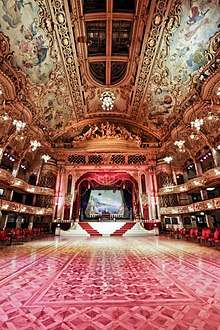
Prior to variety theatre, music halls were the preferred entertainment to the working class communities, both in London and the provinces. Acts including George Robey and Marie Lloyd were deemed "overly racy", according to The Stage, with major theatres banning them in the interests of decency. The restrictions were brief, chiefly because of the dwindling effect it was having on audiences.[55] By the 1880s most music halls were either operated by amateur syndicates who were enthusiastic about the theatrical business and less so about profits, or were the ventures of wealthy businessmen who were, on the whole, uninterested in the entertainment they were staging but not the revenue it brought in. Safety, in both cases, was frequently compromised as it was costly and renovations were often ignored in order to keep costs down. Music halls had, for many years, been a hugely profitable business, but had become the subject of stringent regulations and safety controls. Certainly, by 1880, covert inspections by local authorities were being carried to make sure proprietors were adhering to the safety requirements; the rules were so strict that a lot of the aging halls, particularly those whose proprietors had little money, were forced to close down.[56] Those that remained open were instructed to improve or refurbish their premises to meet expectations. The boom required a need for competent architects who knew how theatres worked.[57][n 9]
Association with Moss Empires and Oswald Stoll
From 1898 to 1910 Oswald Stoll had been the Managing Director of Moss Empires,[58] a theatrical entertainment circuit headed by the impresario Edward Moss which at its height, was responsible for 33 theatres around Great Britain. Matcham first worked for Moss Empires in 1892 on the Empire Palace, in Nicholson Street, Edinburgh.[59] So impressed was he with Matcham's design, Moss commissioned him to design other provincial theatres over the next seven years. His work in London under the impresarios included the Empire in Hackney, and the Coliseum and Hippodrome theatres, both in Westminster. In total, Matcham was responsible for designing 21 theatres for Moss and Stoll over a 20 year period which ended with the Wood Green Empire in Wood Green, in 1912.[59]
County Arcade, Leeds
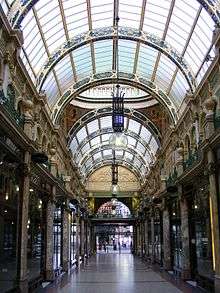
Briggate, one of the oldest streets in Leeds, received a regeneration in the late 1890s and included the building of a number of shopping arcades to accompany the existing Thorntons Arcade, which was completed in 1878. Matcham designed his, the Cross and County Arcades, for the Leeds Estate Company, between 1898 and 1900, at the northern most part of the street.[60] Simultaneous to his work with the County Arcade, Matcham also designed the Empire Palace, for Moss, which was located further down Briggate.[61] The construction costs of the County Arcade were in excess of £300,000.[62][n 10] According to Brian Mercer Walker, Matcham's biographer, the architect took on the designs for the County Arcade in Leeds, either because of a decline in the need for new theatres, or an attempt to try out something new and on a much smaller scale. Either way, Mercer Walker considered the project to be completely out of character for Matcham who had previously displayed such energy and enthusiasm for all his designs.[63] Together with a handful of public houses in London, the County Arcade is rare inasmuch that it is one of the only non-theatrical buildings to be designed by Matcham.[64]
Retirement and death

In 1910 the London Palladium was completed and opened on 26 December. Designs for the Victoria Palace theatre were already underway; it opened the following November. Prior to the opening of the Victoria Palace, Matcham was working alongside Crewe for a new Hippodrome in Bristol which was to become Matcham's last major design.[65]
The interwar period was slow for theatrical architects and builders, mainly because of the introduction of cinema, and many of the theatres that had been designed through Matcham's office were now becoming picture houses.[66] Matcham & Co.'s projects had started to slow down by 1913 with the only theatrical venture being the design of the Palace Theatre, Leicester, that year.[67]
Matcham retired to Southend-on-Sea with his wife shortly before the First World War[68] and left the running of the business to Chancellor and Briggs.[53][69] He died at his house, 28 Westcliff Parade, on 18 May 1920.[69] His death was attributed to blood poisoning, brought about from cutting his finger nails too short.[70] The funeral took place at St. Paul's Church, Finchley, before his interment in the family vault[71] in Highgate Cemetery.[72]
Matcham bequeathed his company, equally, between Briggs and Chancellor.[48] The business continued although it never achieved the same success as it did under Matcham. Upon the outbreak of the Second World War, Chancellor retired and moved to the English countryside, where he died in 1941.[53] Briggs held the business in a dormant state until after the war when the business was sold to a property agency in Covent Garden. It continued, on a small scale, until it was eventually wound up in the late 1970s.[53]
Personal life
Matcham was a devoted if frequently absent husband and father. He married Maria Robinson, the daughter of his tutor, J.T. Robinson, on 9 July 1877 at St. James' Church, Pentonville.[n 11] They had two daughters; Eveline, who was born in 1878,[73] and Constance, in 1884.[3] In an interview with Vanity Fair, Matcham listed an interest in music but admitted that although he owned a Stradivarius Violin, he "wasn't particular good with it." Another hobby was amateur dramatics and on occasion, the Matcham's would stage minor pieces at the family home, "Rathgar", in Dollis Avenue, Finchley, for the entertainment of their neighbours.[1]
The author Brian Marcer Walker notes, from Matcham's personal archives, that the architect was "a man of remarkable vigour and [had an] enthusiasm for life...he possessed a tranquility of mind and [had] a great sense of humour and fun."[1]
Legacy
The total number of theatres Matcham designed is unknown and has been open to much speculation. The theatrical author Victor Glasstone estimated the architects work to include 66 new theatres and the remodelling and restorations of 58 existing buildings, from between 1879 to 1910;[65] however, Matcham's biographer, Brian Mercer Walker, listed him ahead of Matcham's contemporaries, at 92 designs, with the closest to him being Charles J. Phipps, with 47.[74]
From the start of the 1900s Bertie Crewe and W.G.R. Sprague had started to make a name for themselves in architectural circles. It has been suggested by various architectural journals that Crewe and Sprague were pupils of Matcham, although this has since been discounted by Glasstone in his 1975 book Victorian and Edwardian Theatres. Although the author Iain Mackintosh notes a clear Matcham influence in Sprague and Crewe's designs, he describes the former as being more suave compared to Matcham, whilst Crewe, although sharing a lot of Matcham's exuberance, was "more polished" because of his earlier training in Paris.[65] Sir Alfred Butt, writing in The Era, considered: "Frank Matcham lived for his work, and unquestionably was pre-eminent as a theatrical and music hall architect."[71] On 22 November 2007, Matcham was commemorated by a blue plaque at the site of his London home, 10 Haslemere Road, Hornsey.[75]
Notes and references
Notes
- ↑ Charles Matcham originated from Andover in Hampshire, while Frank's mother, Elizabeth, was born and brought up in Islington, London. They married at St Giles in the Fields, then part of Holborn, Middlesex, in 1850. After briefly settling in Andover, shortly before the birth of the eldest child, Elizabeth, in 1851, the Matchams moved to Torquay owing to Charles's desire to capitalise from the increase in tourism in the seaside town.[4][5]
- ↑ George Bridgeman was born in 1839[8] and was the son of John Bridgeman and his wife, Mary née Soudon. Mary Luscombe Bridgeman, John's mother, was the proprietor of the family brewery business at which Charles Matcham worked.[9] The Bridgemans were also neighbours to the Matcham's in Union Street, Torquay, and their probable landlords.[10] George first came to notice when at the age of 23, he helped to design a large residential development in the Roundham area of Paignton. George Bridgeman's employers were responsible for the designs of many local buildings including schools, public houses, and municipal structures. Bridgeman went on to form his own successful drawing office, shortly after Matcham left for London. He was later appointed as the chairman of Paignton Urban District Council and became their principle architect responsible for designing many of the buildings that still make up Paignton.[11]
- ↑ Robinson was one of the leading theatrical architects in Victorian London. His rebuilding of the Old Vic theatre in 1871 was a particularly noted design. Later that decade he became a consulting architect to the Lord Chamberlain of the Household.[19]
- ↑ James Elliston (1852–1920) was born in Edinburgh. He was known as a hard working entrepreneur and had a varied career both on and off the stage. He had been based in Blackburn since 1875 but had previously managed theatres in Liverpool, Bishop Auckland, and Durham.[30]
- ↑ The building was the first purpose built, stone and brick theatre in Stockport. It introduced the latest designs in ventilation and featured an updated version of gas lighting. The auditorium had a capacity of 3,000 and featured tip-up seats in the dress circle and upholstered chairs in the boxes. Local building contractors were used at a cost of £12,000, a fee paid personally by Revill. The theatre was demolished in 1962.[32]
- ↑ Particular attention was paid to the roof which was decorated in crimson, green, electric blue and gold. Three large panels over the proscenium and sides of the auditorium depicted scenes of drama, comedy, poetry, and music. There were with lifesize carvings of Ludwig van Beethoven, Henry Wadsworth Longfellow and William Shakespeare. Two panels flanked the proscenium, one depicting music, the other, drama.[39]
- ↑ In 1996 around 10,000 original drawings were purchased by the Theatre Museum after they were found in a damaged and damp state. The drawings represented 75 buildings, 35 of which were either wholly or in part attributed to Matcham.[46]
- ↑ Francis Graham Moon Chancellor was born in Tasmania and was the lead architect for Matcham & Co. in Matcham's absence.[52] He was the office's chief surveyor and office manager. In 1931 he completed the new Sadler's Wells theatre.[53] Robert Alexander Briggs possessed more of a business mind compared to his colleagues and was an engineer of good standing. He designed the stage machinery for all of Matcham's Hippodromes. He, along with Matcham, purchased the patent for his self-designed cantilever which was specifically used in theatre construction.[54]
- ↑ In Victorian England, theatrical architects were not taken seriously in architectural circles and were often looked upon as being the lesser of a kind.[57]
- ↑ The Empire Palace closed on 25 February 1961 and was demolished the following year.[61]
- ↑ Maria was born in 1858 to Jethro Thomas Robinson and his wife, Hannah née Beedham. Maria initially took her mother's first name at birth, but she went by the name of Maria for most of her life. She died a few months after her husband in 1920.[3]
References
- 1 2 3 Mercer Walker, p. 4.
- 1 2 Mercer Walker, p. 1.
- 1 2 3 Wilmore, p. 217.
- ↑ Civil Registrations Index to Marriages, volume 1, p. 37.
- ↑ "Growing Up On The English Riviera" by Gorel Garlick; Wilmore, p. 30.
- ↑ Vanity Fair, 5 July 1911, p. 17.
- ↑ Mercer Walker, pp. 1–2.
- ↑ "Growing Up On The English Riviera" by Gorel Garlick; Wilmore, p. 39.
- ↑ "Growing Up On The English Riviera" by Gorel Garlick; Wilmore, p. 35.
- ↑ "Growing Up On The English Riviera" by Gorel Garlick; Wilmore, p. 34.
- 1 2 Mercer Walker, p. 2.
- ↑ "Growing Up On The English Riviera" by Gorel Garlick; Wilmore, p. 40.
- 1 2 3 "Growing Up On The English Riviera" by Gorel Garlick; Wilmore, p. 42.
- ↑ "Frank Matcham in Perspective" by Andrew Saint; Wilmore, p. 21.
- ↑ Torquay Directory, 12 April 1871, p. 4.
- ↑ "Tenders", The Builder, 1 March 1873, p. 176.
- ↑ "Growing Up On The English Riviera" by Gorel Garlick; Wilmore, pp. 44–49.
- ↑ "Growing Up On The English Riviera" by Gorel Garlick; Wilmore, p. 49.
- ↑ "Old Vic Theatre", Historic England, accessed 19 September 2017.
- ↑ Mercer Walker, p. 3.
- ↑ Mercer Walker, pp. 5–6.
- 1 2 Mercer Walker, p. 6.
- ↑ Mercer Walker, pp. 6–7.
- ↑ Mercer Walker, p. 10.
- 1 2 Mercer Walker, p. 7.
- ↑ Mercer Walker, p. 68.
- ↑ Mercer Walker, p. 85.
- ↑ "Matcham's Revills'" by Michael Sell; Wilmore, p. 52.
- ↑ "Royalty Theatre, Glasgow", Scottish Theatre Archive, University of Scotland, accessed 20 September 2017.
- 1 2 3 "Matcham's Revills'" by Michael Sell; Wilmore, p. 52–53.
- ↑ "Matcham's Revills'" by Michael Sell; Wilmore, pp. 61–62.
- ↑ "Matcham's Revills'" by Michael Sell; Wilmore, pp. 57–58.
- ↑ The Era, 9 June 1888.
- ↑ "Matcham's Revills'" by Michael Sell; Wilmore, p. 62.
- ↑ Quote from Elliston; "Matcham's Revills'" by Michael Sell; Wilmore, p. 63.
- ↑ "Matcham's Revills'" by Michael Sell; Wilmore, pp. 58–59.
- ↑ "Matcham's Revills'" by Michael Sell; Wilmore, p. 60.
- ↑ "Matcham's Revills'" by Michael Sell; Wilmore, pp. 65–67.
- ↑ Wilmore, p. 67.
- ↑ "Matcham's Revills'" by Michael Sell; Wilmore, p. 64.
- ↑ "Matcham's Revills'" by Michael Sell; Wilmore, p. 69.
- ↑ "Matcham's Revills'" by Michael Sell; Wilmore, pp. 73–75.
- ↑ "Matcham's Revills'" by Michael Sell; Wilmore, pp. 80–81.
- ↑ "Matcham's Revills'" by Michael Sell; Wilmore, p. 89.
- ↑ "Matcham's Revills'" by Michael Sell; Wilmore, p. 88.
- 1 2 "The Matcham Office at Work" by John Earl; Wilmore, p. 92.
- ↑ Wilmore, p. 127.
- 1 2 Wilmore, p. 128.
- 1 2 Wilmore, p. 130.
- ↑ Wilmore, pp. 130–131.
- ↑ The Bognor Post, 2 December 1950, pp. 9–13.
- 1 2 Wilmore, p. 124.
- 1 2 3 4 "The Matcham Office at Work" by John Earl; Wilmore, p. 93.
- ↑ Wilmore, pp. 124–125.
- ↑ "Curtain up - Frank Matcham's London Coliseum", The Stage, 12 February 2004, accessed 4 October 2017.
- ↑ Earl, p. 26.
- 1 2 Earl, pp. 28–29.
- ↑ "Variety theatre: Oswald Stoll", Victoria and Albert Museum, accessed 24 September 2017.
- 1 2 Mercer Walker, p. 158.
- ↑ "Numbers 1-43 and Cross Arcade", Historic England, accessed 3 December 2017.
- 1 2 Mercer Walker, p. 161.
- ↑ Wilmore, pp. 202–203.
- ↑ Mercer Walker, pp. 17–18.
- ↑ Mercer Walker, p. 18.
- 1 2 3 "King Kong versus Godzilla: The Competition for the Royal Opera House at The Hague, 1910-11" by Iain Mackintosh; Wilmore, p. 143.
- ↑ Wilmore, pp. 138–139.
- ↑ Wilmore, p. 129.
- ↑ Wilmore, p. 138.
- 1 2 "Mr Frank Matcham Dead", Western Daily Press, 19 May 1920, p.10.
- ↑ The Architect's Journal, 26 May 1920, p. 682.
- 1 2 Death of Mr. Frank Matcham", The Era, 26 May 1920, p. 6.
- ↑ "Who's Here", Highgate Cemetery, accessed 1 July 2016.
- ↑ Mercer Walker, p. 4.
- ↑ Mercer Walker, p. 94.
- ↑ "Matcham, Frank (1854-1920)", English Heritage, accessed 1 June 2016.
Sources
- Baker, Richard Anthony (2014). British Music Hall: An Illustrated History. South Yorkshire: Penn & Sword History. ISBN 978-1-78383-118-0.
- Earl, John (2008). British Theatres and Music Halls. South Yorkshire: Shire Publications. ISBN 978-0-74780-627-1.
- Earl, John; Sell, Michael (2000). The Theatres Trust Guide to British Theatres 1750-1950. London: A. & C. Black. ISBN 978-0-71365-688-6.
- Kilburn, Mike (2002). London's Theatres. London: New Holland. ISBN 978-1-84330-069-4.
- Mercer Walker, Brian (1980). Frank Matcham: Theatre Architect. Belfast: Blackstaff Press. ISBN 978-0-95341-271-6.
- Wilmore, David (2008). Frank Matcham & Co. South Yorkshire: Theatreshire Books. ISBN 978-0-85640-231-9.